Issues

The January issue of Canadian MoneySaver is here to help you start off 2025 strong. Whether you’re navigating taxes as a brand-new entrepreneur, curious about cracking the code of technical analysis, or ready to dodge all-too-common investor pitfalls, we’ve got you covered.
Featuring: Ryan Modesto, Keith Richards, Fred J. Masters, Laura Harvey, Michael Huynh, Benj Gallander,...
View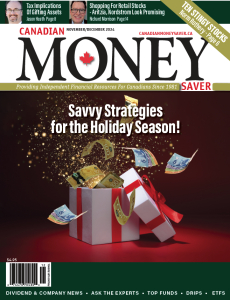
The holiday season is quickly approaching, and Canadian MoneySaver is giving you the gift of expert insight! Unwrap the latest issue for insights on gifting assets, how inflation will impact your holiday budget, and how retail stocks are stacking up this season.
Plus, indulge in a feast of stingy stocks and imbibe (or not?) in booze brands. It’s all in the November/December issue of Canadian MoneySaver.
Featuring: Norm Rothery, Jason Heath, Julie Petrera, Ryan Modesto, Richard Morrison, Rita Silvan, Rino...
View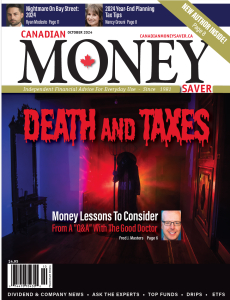
Life may have its certainties — death and taxes — but this October, we’re flipping the script in the latest issue of Canadian MoneySaver! Get ready to dive into the spooktacular world of finance as we explore the financial side of life’s big events, savvy investing for your golden years, and clever year-end tax tricks that will treat your wallet!
Join us for a thrilling ride filled with insights and surprises — let’s make those scary topics a little less spooky and a lot more fun!
Featuring: Fred J. Masters, Nanci Grouni, Ryan Modesto, Richard Morrison, Rita Silvan, Julie Petrera, John...
View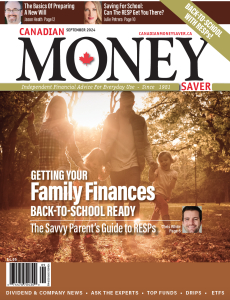
Get back-to-school ready in this issue of Canadian MoneySaver! In this month's issue we cover the topic of RESPs as well as Wills and tools to help predict market returns.
Get your finances back-to-school ready with the September issue!
Featuring: Chris White, Julie Petrera, Jason Heath, Richard Morrison, Rita Silvan, Zachary Diaz, Brian Chang
View
In this issue of Canadian MoneySaver, our contributors touch on topics ranging from the family cottage, value investing and a half year market outlook.
Featuring: Hannah McVean, Richard Morrison, Rita Silvan, Zach Diaz, John DeGoey, Barbara Stewart, Ken Kivenko
View
Hopefully, MoneySavers who have been with us for a while (43 years now!) have enjoyed some financial success from reading the articles we publish by our esteemed group of expert contributors.
If you are a newer reader, hopefully we can help you on your way to financial success and independence. That's our goal.
But, some recent personal events have reminded us that money is not the only thing.
Maybe it is because we are getting old (sigh), but we are seeing friends with health problems, parents passing away and lots of people stressing over inconsequential things.
Money is helpful, for sure, but it cannot stop the clock. It can't buy sleep or happiness, or health. It can't buy friends. We think it should not be someone's main focus.
In fact, if you plan things properly, most portfolios can run themselves most of the time.
You do not need to know everything about a company, if it has performed well for 20 years. It won't change its stripes. You don't need to listen to every company’s quarterly conference calls.
Featuring: Rita Silvan, Jason Heath, Frank Masters, Steven Brennan, Rino Racanelli, Colin Ritchie
View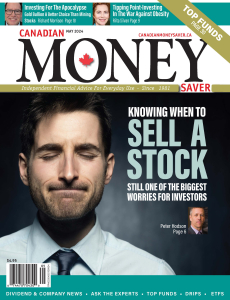
As we write this, in mid April, we note that both US and Canadian markets are reporting all-time highs.
Markets are doing very well, as investors anticipate earnings growth, lower inflation and lower interest rates ahead.
This is all well and good, but some investors worry about new highs. Of course, whenever there is a new high there is lots of chatter about a market 'correction', 'set back', or even 'crash'. But markets are supposed to go up. New highs make for some media chatter, but they don't really tell investors much. Recent new highs generally just surpass levels set in 2021, so another way of looking at things is to say that markets haven't really done that much in
a couple of years.
Further, new highs are actually not uncommon. On average, there are 16 new highs every single calendar year. Also, even if one invests at new high levels, returns end up being very
close to investing at lower levels.
So, enjoy the new highs as they come. But don't put too much 'stock' in them. They don't mean a crash, and they are nothing to worry about, certainly.
Sharing with You,
Peter Hodson, Editor
Featuring: Richard Morrison, Rita Silvan, John De Goey, Chris White, Peter Hodson, Ed Arbuckle
View
One of the hardest things for an investor to do is to NOT SELL a company whose shares are surging.
When a stock is flying, many will say it's a bubble. Many will say the move is unsustainable. Many will say it is overvalued.
But is it?
One tip for investors who find themselves in the happy position of owning a stock up
100%, 200%, 300% or more is to ignore the stock price. That's right, ignore it. Look only
at the fundamentals. How is earnings growth? How is cash flow? Are sales accelerating? Is
debt being paid down? Is the company buying back stock? Are insiders buying?
We've noticed many stocks this year rising rapidly. Many are in the AI field. But many, such
as Eli Lilly (up 21% year to date and 111% over one year), are simply great growth companies.
In many cases, though, earnings growth is faster than stock price gains. What does this
mean? Well, it means even at a much higher stock price, your stock might actually be cheaper than it was before, due to its fast earnings growth.
So, before simply selling, look under the hood. Your 'expensive' stock might actually be
'cheap', if it is growing fast enough.
Sharing with You,
Peter Hodson, Editor
Featuring: Rita Silvan, Barbara Stewart, Janet Gray, Richard Morrison, Danielle Neziol, Lana Sanichar, Brian...
View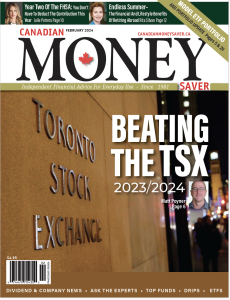
Last year once again reminded us of the importance of staying invested. The
market in 2023 started off strong, dipped, recovered, dipped again, then had a
big run in the fourth quarter.
Traders and short-investors likely had a very hard time: In 2023 one minute the world was
ending with high inflation, high interest rates and a looming recession. The next minute,
rates were falling, economists were talking about a 'soft landing' and all was good again.
But investors who simply held on, or, better yet, kept buying on a regular basis, likely
did very well in 2023. We enjoyed a solid 2023 performance, but a lot of it came in the last
nine weeks of the year, and the move was enough to make up for several mistakes (yes, we
still make those!).
So, as 2024 moves unrelentingly forward, keep this in mind: it is not timing the market,
it is time IN the market. Yes, a very old stock market saying. But, clearly, one of the best:
give your companies enough time to make you wealthy.
Peter Hodson CFA
Founder and Head of Research
5i Research Inc.
Featuring: Matt Poyner, Julie Petrera, Rita Silvan, Colin Ritchie, Chris White, Barbara Stewart, Michael Huynh
View
